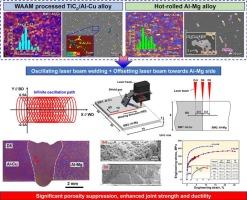热轧Al-Mg异种铝合金与增材制造Al-Cu的振荡激光束焊接:激光束偏移的作用
IF 5
2区 物理与天体物理
Q1 OPTICS
引用次数: 0
摘要
TiC颗粒增强Al-Cu合金的电弧增材制造(WAAM)在快速制造大型轻型航空航天结构方面显示出巨大的潜力,这些结构通常需要随后与传统加工的合金连接。然而,当waam制备的Al-Cu与热轧Al-Mg合金连接时,存在严重的气孔缺陷和接头性能受限的问题。为了解决这些问题,本研究研究了waam制造的TiCp/Al-Cu合金和热轧Al-Mg异种合金的振荡激光束焊接。研究了激光束偏移对Al-Cu + Al-Mg异种铝合金热轧接头焊缝缺陷、显微组织演变和力学性能的影响。结果表明,当激光束向Al-Cu侧偏移0.5 mm时,焊缝组织细化,气孔率增大,热影响区软化区扩大;相反,向Al-Mg侧偏移0.5 mm的激光束可以有效地抑制气孔缺陷,减少软化,从而获得最佳的力学性能,极限拉伸强度为300 MPa,延伸率为6.2%。激光束偏移有效地调节了熔合比,从而调节了焊缝内合金元素、氢含量和孕育剂颗粒的分布。这种方法为克服不同铝合金焊接的关键挑战提供了新的见解,特别是在不同的贱金属加工方法下。本文章由计算机程序翻译,如有差异,请以英文原文为准。

Oscillating laser beam welding of additively manufactured Al-Cu with hot-rolled Al-Mg dissimilar aluminum alloys: The role of laser beam offset
Wire arc additive manufacturing (WAAM) of TiC particle-reinforced Al-Cu alloy shows great potential for rapid manufacturing of large-scale lightweight aerospace structures, which often require subsequent joining with conventionally processed alloys. However, when WAAM-fabricated Al-Cu is joined to hot-rolled Al-Mg alloy, severe porosity defects and limited joint performance remain challenging issues. To address these challenges, this study investigates oscillating laser beam welding of WAAM-fabricated TiCp/Al-Cu alloy and hot-rolled Al-Mg dissimilar alloys. Effects of laser beam offset on weld defects, microstructural evolution, and mechanical properties of additively-manufactured Al-Cu with hot-rolled Al-Mg dissimilar aluminum alloy joints are aimed to be elucidated. The results indicate that a 0.5 mm laser beam offset towards the Al-Cu side refines the weld grain structure but increases porosity and expands the heat-affected zone softening region. In contrast, offsetting laser beam 0.5 mm towards Al-Mg side effectively suppresses porosity defects and reduces softening, resulting in optimal mechanical properties with an ultimate tensile strength of 300 MPa and elongation of 6.2 %. Laser beam offset effectively adjusts the fusion ratio, thereby regulating the distribution of alloying elements, hydrogen content, and inoculant particles within the weld seam. This approach offers novel insights into overcoming critical challenges in dissimilar aluminum alloy welding, particularly under varying base metal processing methods.
求助全文
通过发布文献求助,成功后即可免费获取论文全文。
去求助
来源期刊
CiteScore
8.50
自引率
10.00%
发文量
1060
审稿时长
3.4 months
期刊介绍:
Optics & Laser Technology aims to provide a vehicle for the publication of a broad range of high quality research and review papers in those fields of scientific and engineering research appertaining to the development and application of the technology of optics and lasers. Papers describing original work in these areas are submitted to rigorous refereeing prior to acceptance for publication.
The scope of Optics & Laser Technology encompasses, but is not restricted to, the following areas:
•development in all types of lasers
•developments in optoelectronic devices and photonics
•developments in new photonics and optical concepts
•developments in conventional optics, optical instruments and components
•techniques of optical metrology, including interferometry and optical fibre sensors
•LIDAR and other non-contact optical measurement techniques, including optical methods in heat and fluid flow
•applications of lasers to materials processing, optical NDT display (including holography) and optical communication
•research and development in the field of laser safety including studies of hazards resulting from the applications of lasers (laser safety, hazards of laser fume)
•developments in optical computing and optical information processing
•developments in new optical materials
•developments in new optical characterization methods and techniques
•developments in quantum optics
•developments in light assisted micro and nanofabrication methods and techniques
•developments in nanophotonics and biophotonics
•developments in imaging processing and systems

 求助内容:
求助内容: 应助结果提醒方式:
应助结果提醒方式:


